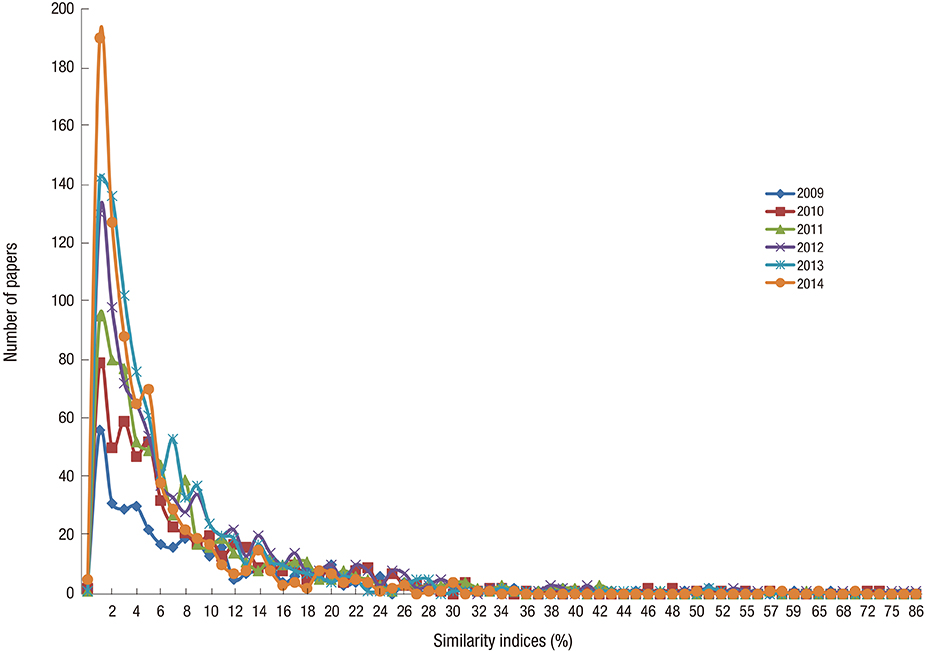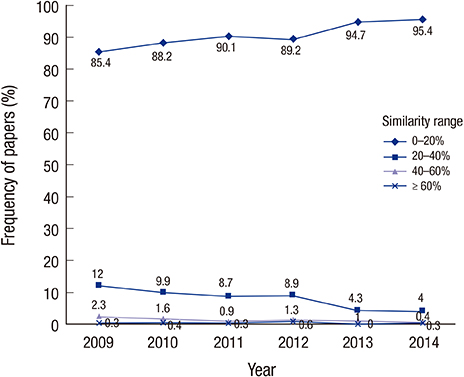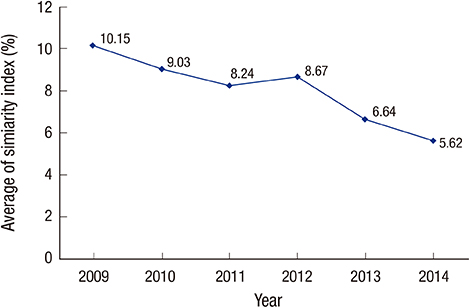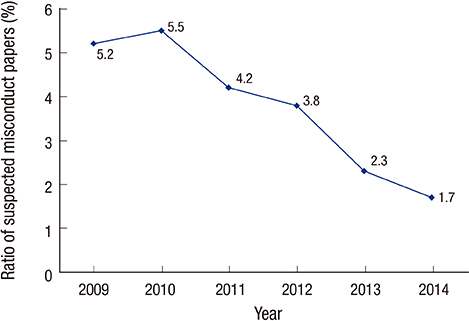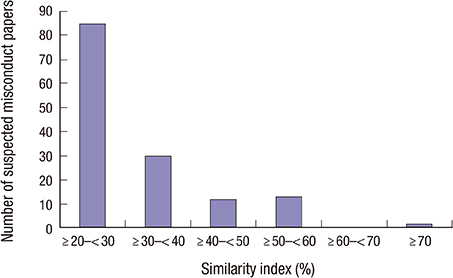J Korean Med Sci.
2017 Jun;32(6):887-892. 10.3346/jkms.2017.32.6.887.
Similarity Analysis of Korean Medical Literature and Its Association with Efforts to Improve Research and Publication Ethics
- Affiliations
-
- 1Asan Medical Library, University of Ulsan College of Medicine, Seoul, Korea.
- 2Department of Medical Humanities and Social Sciences, University of Ulsan College of Medicine, Seoul, Korea. ymkoo@amc.seoul.kr
- KMID: 2377716
- DOI: http://doi.org/10.3346/jkms.2017.32.6.887
Abstract
- In the present study, the frequency of research misconduct in Korean medical papers was analyzed using the similarity check software iThenticate®. All Korean papers written in English that were published in 2009 and 2014 in KoreaMed Synapse were identified. In total, 23,848 papers were extracted. 4,050 original articles of them were randomly selected for similarity analysis. The average Similarity Index of the 4,050 papers decreased over time, particularly in 2013: in 2009 and 2014, it was 10.15% and 5.62%, respectively. And 357 (8.8%) had a Similarity Index of ≥ 20%. Authors considered a Similarity Index of ≥ 20% as suspected research misconduct. It was found that iThenticate® cannot functionally process citations without double quotation marks. Papers with a Similarity Index of ≥ 20% were thus individually checked for detecting such text-matching errors to accurately identify papers with suspected research misconduct. After correcting text-matching errors, 142 (3.5% of the 4,050 papers) were suspected of research misconduct. The annual frequency of these papers decreased over time, particularly in 2013: in 2009 and 2014, it was 5.2% and 1.7%, respectively. The decrease was associated with the introduction of CrossCheck by KoreaMed and the frequent use of similarity check software. The majority (81%) had Similarity Indices between 20% and 40%. The fact suggested that low Similarity index does not necessarily mean low possibility of research misconduct. It should be noted that, although iThenticate® provides a fundamental basis for detecting research misconduct, the final judgment should be made by experts.
Keyword
MeSH Terms
Figure
Cited by 2 articles
-
Similarity and Plagiarism in Scholarly Journal Submissions: Bringing Clarity to the Concept for Authors, Reviewers and Editors
Aamir Raoof Memon
J Korean Med Sci. 2020;35(27):e217. doi: 10.3346/jkms.2020.35.e217.Characteristics of Retracted Publications From Kazakhstan: An Analysis Using the Retraction Watch Database
Burhan Fatih Kocyigit, Alikhan Zhaksylyk, Ahmet Akyol, Marlen Yessirkepov
J Korean Med Sci. 2023;38(46):e390. doi: 10.3346/jkms.2023.38.e390.
Reference
-
1. Korean Association of Medical Journal Editors. Ten-year History of the Korean Association of Medical Journal Editors. Seoul: Korean Association of Medical Journal Editors;2008.2. Korean Association of Medical Journal Editors. Good Publication Practice Guidelines for Medical Journals. 2nd ed. Seoul: Korean Association of Medical Journal Ediotrs;2013.3. Korean Association of Academic Societies. Guideline for Research Ethics. Seoul: Korean Association of Academic Societies;2010.4. Hwang ES, Cho EH, Kim YM, Park GB, Son HC, Yoon TW, Lim JM. Manual for research and publication ethics in science and engineering [Internet]. accessed on 10 June 2015. Available at http://www.cre.or.kr/board/?board=textbook&no=1384677.5. Seoul National University (KR). Seoul National University's guideline for research ethics [Internet]. accessed on 10 June 2015. Available athttp://www.snu.ac.kr/research/images/down/research_08.pdf.6. Lee IJ. The understanding of research ethics for a desirable academic writing. Endocrinol Metab (Seoul). 2011; 26:12–24.7. Kim SY, Bae CW, Hahm CK, Cho HM. Duplicate publication rate decline in Korean medical journals. J Korean Med Sci. 2014; 29:172–175.8. Crossref (US). CrossCheck members [Internet]. accessed on 4 June 2015. Available at http://www.ithenticate.com/products/crosscheck.9. Korean Association of Medical Journal Editors. CrossCheck journals [Internet]. accessed on 1 November 2014. Available at http://www.kamje.or.kr/intro.php?body=crosscheck.10. Kwon OH. What is CrossCheck? [Internet]. accessed on 28 November 2014. Available at http://www.kamje.or.kr/workshop/2012/0216/11.pdf.11. Lee JH. Analysis of CrossCheck data on two years' worth of papers submitted to archives of plastic surgery. Arch Plast Surg. 2014; 41:449–451.12. Zhang Y. CrossCheck: an effective tool for detecting plagiarism. Learn Publ. 2010; 23:9–14.13. Zhang Y, Jia X. A survey on the use of CrossCheck for detecting plagiarism in journal articles. Learn Publ. 2012; 25:292–307.14. Huh S. What happened when CrossCheck was not used for a month in Journal of Neurogastroenterology and Motility? J Neurogastroenterol Motil. 2014; 20:417–418.15. Wager L. How should editors respond to plagiarism? COPE discussion paper [Internet]. accessed on 1 June 2015. Available at http://publicationethics.org/files/COPE_plagiarism_disc%20doc_26%20Apr%2011.pdf.16. Institute of Electrical and Electronics Engineers (US). User's guide for the IEEE CrossCheck portal and prohibited authors list databases [Internet]. accessed on 1 June 2015. Available at https://www.ieee.org/publications_standards/publications/rights/crosscheck_portal_users_guide.pdf.17. Bae CW, Kim SY, Huh S, Hahm CK. Sample Cases of Duplicate Publication. Seoul: Korean Association of Medical Journal Editors;2011.
- Full Text Links
- Actions
-
Cited
- CITED
-
- Close
- Share
- Similar articles
-
- Research Ethics Issues that Frequently Arise in Health Services Researches
- The Acceptable Text Similarity Level in Manuscripts Submitted to Scientific Journals
- Evaluation of a Team-Based Learning Tutor Training Workshop on Research and Publication Ethics by Faculty and Staff Participants
- Author and Authorship in Reporting Medical Papers
- Research Ethics in the Process of Conducting Research


